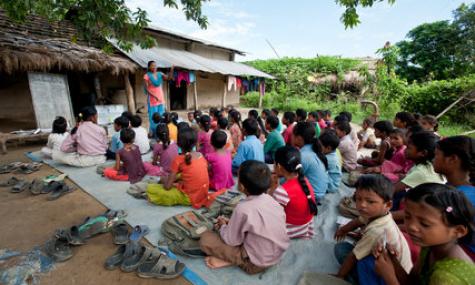More than a third of all primary-school age children around the world still cannot read or write, whether they attend school or not.
The good news? A new report from Save the Children shows that teaching children early-on how to read not only in school but also through activities outside the classroom effectively boosts reading ability.
"Worldwide, 250 million children of primary school age cannot read or write. Going to school isn't enough to guarantee learning," said Carolyn Miles, president and CEO of Save the Children.
"The gap in reading ability between strong and struggling readers widens with age, which is why it's critically important that children learn to read early on."
In its report, Beyond School Walls: A Boost for Readers, Save the Children reviewed results from the first year of its Literacy Boost program in seven participating countries of Bangladesh, Ethiopia, Malawi, Mozambique, Nepal, Pakistan and Zimbabwe.
The key part of Literacy Boost is to expose children to as much reading as possible. In some instances, this may be as basic as the teacher writing on a blackboard, but the Literacy Boost program is also helping to create a ‘Book Bank’ in schools – a mini-library of up to 250 books for children to take home with them.
In many places, where Indigenous language books are not common, this has meant Save the Children has worked with local publishers, non-government groups and Education departments to print book. But books can also be home made, which adults and children writing and drawing their stories.
Literacy Boost also works with the community, parents and teachers. Children take home the books to read with parents and older siblings, with community volunteers leading reading camps for villages and households where necessary. Some villages have introduced a regular ‘reading fair’ with reading contents, storytelling and exhibitions of student books.
“Parents who don’t read can still help children by telling the stories, teaching them words and asking children what they learned that day,” says Save the Children’s senior education advisor, Amy Jo Dowd.
“When a child brings home a picture book, even an illiterate parent can sit with them and make up phrases describing the pictures.”
After one year of participation in the Literacy Boostprogram, students have shown “significant” reading gains and they attended class more often.
Ms Dowd said on the major problems is the lack of teachers. World Bank studies have shown absenteeism amongst teachers in some of the countries in which Save the Children operates is about 20%.
Other highlights
- Girls attending Literacy Boost learned 6.5 times more letters of the alphabet in Pakistan, and 2.5 times more letters in Nepal, than female students who did not enrol in the program.
- In Zimbabwe and Pakistan, female students participating in Literacy Boost made nearly twice as much progress in reading words and sentences correctly than girls not enrolled in the program.
- In Ethiopia and Zimbabwe, Literacy Boost students from homes with the fewest books more than doubled their word-reading ability over the course of the year.
- In Pakistan and Malawi, Literacy Boost students from homes with the fewest books made three times as much progress in understanding what they read as their peers not enrolled in the program.
The report has been released as part of the lead-up to this month’s meeting of world leaders at the United Nations headquarters in New York to review progress towards achievement of the UN Millennium Development goals on getting and keeping more children in school.
"The new research shows that now is the time to think of creative ways to foster in all children a lifelong love of learning that extends beyond school," said Ms Miles.
"We urge the decision-makers to think outside the box and take a closer look at Save the Children's approach to learning in and out of the classroom, which in just one year has proven effective in seven countries."


















__small.png)










